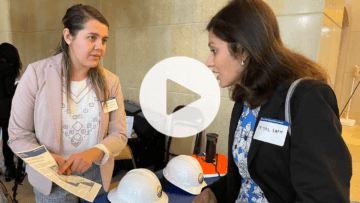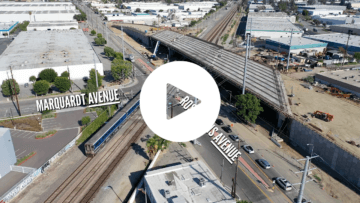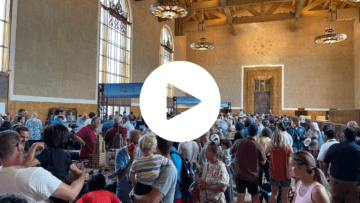|
Statewide News |
Northern California |
Southern California |
FAQs & Upcoming Events |
Ending the Year With Major Progress for High-Speed Rail in California
As 2023 ends, we wanted to share with you all the tremendous progress we’ve made over the last year. We’ve been crossing milestones and turning the corner from focusing exclusively on construction to looking ahead to operations. Many of you have seen a glimpse at our future high-speed trainsets – the first in the U.S., our world-class stations are coming into focus in the Central Valley, and we’re in true alignment with our federal partner to bring high-speed rail to the U.S.
Earlier this month, we received truly historic news for the project when we learned we had been awarded nearly $3.1 billion in Federal-State Partnership grant funds from the U.S. Department of Transportation through the Infrastructure Investment and Jobs Act (IIJA). It’s the largest award of federal funds this project has ever received and is critical to advancing Merced – Bakersfield inaugural passenger service by the end of the decade. Governor Newsom weighed in on this historic event:
“California is delivering on the first 220-mph, electric high-speed rail project in the nation. This show of support from the Biden-Harris Administration is a vote of confidence in today’s vision and comes at a critical turning point, providing the project new momentum.”
 Our supporters also had a lot to say about this good news and we grabbed some significant media attention at the state and national level. On December 8, Speaker Emerita Nancy Pelosi, Congressman Jim Costa, Senior Advisor to the President and White House Infrastructure Coordinator Mitch Landrieu, Governor Jerry Brown, General President of the United Brotherhood of Carpenters and Joiners of America Doug McCarron and Authority CEO Brian Kelly held a virtual press conference with over 60 media outlets to talk about this landmark investment in our system, and during the call, both Speaker Emerita Pelosi and Representative Costa reiterated their commitment to continuing to move the project forward at the federal level.
Our supporters also had a lot to say about this good news and we grabbed some significant media attention at the state and national level. On December 8, Speaker Emerita Nancy Pelosi, Congressman Jim Costa, Senior Advisor to the President and White House Infrastructure Coordinator Mitch Landrieu, Governor Jerry Brown, General President of the United Brotherhood of Carpenters and Joiners of America Doug McCarron and Authority CEO Brian Kelly held a virtual press conference with over 60 media outlets to talk about this landmark investment in our system, and during the call, both Speaker Emerita Pelosi and Representative Costa reiterated their commitment to continuing to move the project forward at the federal level.
Later that same day, President Biden held a press conference in Las Vegas to recognize our project and the Brightline West planned rail line between Las Vegas and Southern California that received almost $3 billion in grants as well. He reminded the crowd that as Vice President under President Obama, he oversaw the rollout of the American Recovery and Reinvestment Act (ARRA) that granted us the initial infusion of federal funds to our project and emphasized why this new federal infusion of money is such a big deal.
 “To put all of this in perspective, this project in California is the most ambitious rail project in the entire Western hemisphere. It’s expected to carry 31 million passengers a year, will be 100 percent powered by renewable energy, and, once again, this project is about jobs. It’s already created 12,000 good-paying union construction jobs, with thousands more to come,” said President Joe Biden.
“To put all of this in perspective, this project in California is the most ambitious rail project in the entire Western hemisphere. It’s expected to carry 31 million passengers a year, will be 100 percent powered by renewable energy, and, once again, this project is about jobs. It’s already created 12,000 good-paying union construction jobs, with thousands more to come,” said President Joe Biden.
The President praised our project by highlighting how it will take people from Los Angeles, through the Central Valley, all the way to San Francisco in less than three hours and talked about how the train will transform California’s Central Valley with new businesses, new residents, visitors, and economic opportunities.
Funds from this federal-state partnership grant will be utilized in the Central Valley to:
- Fund six electric trains for testing and use
- Fund design and construction of trainset facilities
- Fund design and construction of the Fresno station
- Fund final design and right-of-way acquisition for the Merced and the Bakersfield extensions
- Fund construction in the Central Valley
In addition to the Federal State Partnership grant, we also received an additional $500,000 from the Corridor Identification and Development Program, which will allow us to position ourselves to quickly advance work outside of the Valley when opportunities become available – and we will be aggressively pursuing those opportunities. With this award, in total, the Authority has received more than $3.3 billion in funding from IIJA, and we are planning to compete aggressively for billions more in the coming years.
Other milestones to celebrate include the near completion of Construction Package 4 and the record 10 structures we completed in the Central Valley this year. Our teams are working incredibly hard to get us to where we are today, and that has been reflected by the good paying jobs our project is creating. To date, we’ve created over 12,000 jobs, dispatched a record number of daily workers of over 1,600, and entered an agreement with 13 labor unions on high-speed rail operations. This pace of work is particularly impressive considering the Valley was impacted by historic floods, and our staff and our contractors worked closely with businesses and residents in the Valley to assist them. CEO Kelly recapped the latest on construction in his December CEO Report to the Authority’s Board of Directors.
In Northern and Southern California, we continue to make progress as well. Our partners at Caltrain tested their first electric trains as they continue to move forward with electrification in the region, and our Northern California team continues to work with local and regional stakeholders to position us to move forward with high-speed rail when funding becomes available. In Southern California, we reached a settlement with Hollywood Burbank Airport regarding our project alignment in the Burbank area, and we issued a new Supplemental Alternatives Analysis that lays out a path forward on the Los Angeles to Anaheim project section. More updates from the regions can be found below in this newsletter.
There’s lots to come in 2024, and we want to wish you all the best of holidays and a happy new year.
ICYMI – Fall 2023 Construction Update
 In November, we released our Fall 2023 Construction Update! The update highlights the 10 high-speed rail structures that have been completed or opened to traffic this year and our new record average of 1,612 workers dispatched to a high-speed rail construction site daily.
In November, we released our Fall 2023 Construction Update! The update highlights the 10 high-speed rail structures that have been completed or opened to traffic this year and our new record average of 1,612 workers dispatched to a high-speed rail construction site daily.
It also features the near completion of Construction Package 4, the southernmost 22-mile stretch of active high-speed rail construction in California’s Central Valley, and progress at high-speed rail structures like the Conejo Viaduct in Fresno County, Hanford Viaduct in Kings County, and Tule River Viaduct in Tulare County.
Haga clic aquí para la versión en Español.
Small Business and Procurement Update
We’re continuing our outreach to make sure small business plays a big role in delivering high-speed rail! In late October, we held a Small Business Diversity and Resource Fair in Sacramento, welcoming over 100 attendees. This event provided attendees with opportunities for face-to-face networking and featured project updates, meetings with prime contractors, engaging discussions on project opportunities, and a discussion about how to overcome barriers facing small businesses.
All small businesses out there are essential to building this high-speed rail program and we were happy to connect with them in person. This will be an annual event, so keep an eye out for the next one. Check out the video from the event!
On the procurement front, our work is continuing to ramp up. In our last edition, our Board of Directors had just approved the release of a Request for Qualifications (RFQ) for high-speed trainsets to industry.
Since then, in early November, our Board approved the release of an RFQ to industry for design services for track and overhead contact systems (OCS) for the initial 171-mile passenger service connecting Merced to Bakersfield. With a total contract value of up to $131.2 million and potential extension options, this procurement process will allow us to:
- Produce high-level designs for track and systems for the 171-miles connecting Merced to Bakersfield, including detailed designs for the 119-mile stretch currently under active construction within that Central Valley stretch.
- Design the track system, including the track structure, OCS, along-track cable containment, across-track ducts, access walkways, fencing, and drainage.
- Manage technical and non-technical interfaces with interfacing contractors/ consultants.
To help advance procurements, we hosted an Industry Awareness Day in mid-November that provided information on the current and upcoming procurements aimed at delivering the first 171-mile operational segment of the California High-Speed Rail project. This event was designed to raise awareness about this project throughout the global high-speed rail industry and cultivate a competitive procurement process.
The interest was palpable during the event which attracted firms from across trades to learn more about the multiple procurement opportunities with the nation’s largest, green infrastructure project to connect California’s mega-regions!
As we head into 2024, you can look forward to continued outreach to small businesses and industry as we work to deliver this historic project. In the meantime, you can learn about our Small Business Program and procurements at our Business Opportunities webpage.
| UPDATES FROM NORTHERN CALIFORNIA |
Perseverance Amid a Pandemic
 Every Veterans Day, Brian Ross follows a few traditions.
Every Veterans Day, Brian Ross follows a few traditions.
The former U.S. Army Platoon leader calls and checks on soldiers in his unit, enjoys some Veterans Day deals with his children, and at the end of the day, serves his family an MRE dinner.
“It’s basically the prepackaged meal packs that they give to soldiers out in the field and they’re horrible,” he said with a laugh.
These small traditions are a means to reflect on his military service and how it has shaped his life now as the Principal and Managing Director of Ross Infrastructure Development, LLC. It is a Bay Area-based Disabled Veteran Business Enterprise (DVBE) certified small business. Presently, it supports KPMG in its financial advisory engagement and oversight role for the California High-Speed Rail Authority (Authority), Ross’s first major client.
“The Authority is a major reason why I have my small business and why I’ve been able to be successful,” he said as he reflects how his foundational military experience and leap into entrepreneurship with the Authority aligned.
Ross spent eight years in the U.S. Army, including a year-long tour in Afghanistan leading an engineering unit working on route clearance, searching for Improvised Explosive Devices, and overseeing base construction while facing attacks and threats. In his leadership role, Ross earned a Bronze Star and was named Engineer Platoon Leaders of the Year in 2011.
“The ability to handle stress and being calm under pressure was very important,” Ross explained.
Fast forward to 2020, when the COVID-19 pandemic shut down many businesses, Ross faced new pressures and threats in a climate of uncertainty just three years into starting his own firm. “Work pretty much dried up,” he said. “Invoices weren’t being processed; payments weren’t being processed. The state was unsure of what the budget impacts were. There was about a year with no income coming in.”
His military training and experience as a DVBE with the Authority shared the qualities of honesty, respect, and integrity; all of which he drew on to persevere through the pandemic.
“You got to keep going and keep moving forward,” he said. “I didn’t give up and fold the business and go find another job,” he said. Instead of giving up, he pivoted and diversified his business.
“When I first started the business, I pretty much waited for contracts and engagements to come to me. I was more passive. Then, going through the pandemic, I really became more proactive and more aggressive about going out there and finding work and trying to grow the business and building relationships,” he said.
Working on the high-speed rail project he says will be full of challenges, but it’s nothing he shies away from. This large infrastructure project is already positively impacting the economy and veterans like himself.
“I’m really excited to be part of figuring out the funding and financing challenges to make sure that this transformational generational project moves forward,” Ross says.
He says DVBE business owners are sometimes treated as a means to fill a quota, but his work with the Authority challenges that. Ross says, “I’m here because I’m an expert in my field. I add value, and it just so happens to check this box.”
Authority Wins Employer of the Year Award
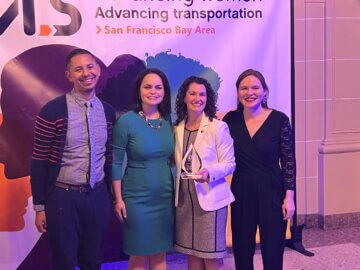 “You don’t look like you work for the California High-Speed Rail Authority.”
“You don’t look like you work for the California High-Speed Rail Authority.”
Those were the words that recently greeted Morgan Galli, Deputy Northern California Regional Director, when she visited a site in South Santa Clara County recently.
What does a person who works for the Authority even look like?
This was the story Galli shared while accepting the prestigious 2023 Employer of the Year Award at the Women’s Transportation Seminar (WTS) – San Francisco Bay Area Chapter’s annual gala in September. The award recognizes the Authority’s work, efforts, and initiatives in fostering success for women and minorities.
In 2019, a report from the Mineta Transportation Institute revealed women make up less than 15% of all transportation workers, while U.S. Bureau of Labor and Statistics reports indicate women made up just 7% of the rail industry.
In what is traditionally considered a male-dominated field, the Authority bucks the trend.
“This organization is not striding ahead in rail transportation but is making great strides for women in the industry,” said Dulce Morales, WTS San Francisco Bay Area Chapter Board Member. “Their equity program is so amazing. They have 50% women in their labor force (staff) and 67% of their executive staff are women. I don’t think we hear that very often.”
Earlier this year, the Authority was recognized by WTS International as Employer of the Year and by the WTS Sacramento and Los Angeles chapters in 2022 as Employer of the Year. In January 2023, the Authority’s “I Will Ride” program received the prestigious Rosa Parks Diversity Leadership Award, which recognizes a transportation organization that has contributed significantly to promoting diversity, inclusion and multicultural awareness. Next January, Authority Chief of Strategic Communications Melissa Figueroa will be recognized as the 2023 Woman of the Year by the WTS Sacramento chapter at their annual Awards and Scholarship Dinner. Those interested in purchasing a ticket to support the event can do so here.
WTS, an 8,000-plus-strong organization with chapters throughout the U.S. and Canada, is dedicated to shaping the future of transportation for the public good through the global advancement of women.
Virtual Reality Tours of Preliminary Train Interior Designs Light Up Winterfest in San Francisco
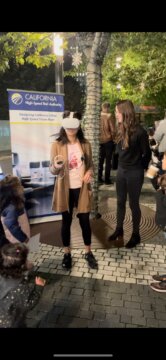 “Wow! This is a fancy train!”
“Wow! This is a fancy train!”
That was the common reaction among San Francisco locals who experienced a virtual reality tour of California High-Speed Rail’s preliminary train interior designs at Salesforce Park’s Winterfest. It’s an annual family-fun holiday event hosted by the Transbay Joint Powers Authority (TJPA), which oversees the Portal Project, a transformative investment that will extend Caltrain service from Fourth and King Street to the multimodal Salesforce Transit Center, the future home of California High-Speed Rail.
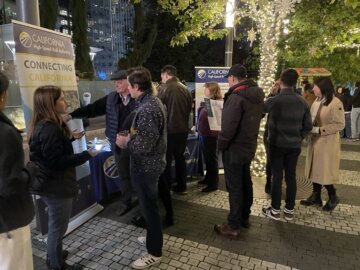 This was the first time the VR headset tour was made available in Northern California. It highlights features such as a children’s play area and accessibility under the Americans with Disabilities Act. Participants noted that the design was unlike any train or vehicle they’ve experienced and were excited to share their input on what they thought should be on the train of the future. Children were especially thrilled to experience the train interiors, exclaiming that unlike airplanes or present-day trains that keep them confined to rows of seats, these new designs would allow them to move about.
This was the first time the VR headset tour was made available in Northern California. It highlights features such as a children’s play area and accessibility under the Americans with Disabilities Act. Participants noted that the design was unlike any train or vehicle they’ve experienced and were excited to share their input on what they thought should be on the train of the future. Children were especially thrilled to experience the train interiors, exclaiming that unlike airplanes or present-day trains that keep them confined to rows of seats, these new designs would allow them to move about.
At the holiday lighting kick-off, which took place on the heels of the Authority’s $3.1 billion Federal-State grant award, local lawmakers applauded TJPA and the Authority for hard work in getting rail into the Salesforce Transit Center. “Get excited transit nerds!” Rafael Mandelman, San Francisco Board of Supervisors and TJPA Board member told the audience. “There’s a giant box underneath here waiting for trains that will someday, we’ll be able to get on a train and ride high-speed rail all the way to Southern California and maybe one day, Sacramento. It’s going to happen!”
Authority Staffer Rides 800 Miles for Transit Month
There are people who advocate for public transit and there are people who live and breathe it, like Northern California Senior Outreach Specialist Jean-Paul Torres. As part of the annual Bay Area Transit Month ride contest in September, Torres logged 121 rides on 18 transit systems. He traveled a total of 856 miles in just 19 days. Torres ranked 30 out of 383 on the leaderboard under the pseudonym ‘blended’.
 “I’ve always noticed the ride contest and thought to join in years past, but this year I decided to dive in headfirst given it would be really easy for me to log miles from my routine Caltrain ride to work and home (41 miles from San Francisco to the Northern California Regional Office in San Jose),” Torres said. “What I ended up loving was the mileage stats I would get after logging a trip, which really helped to put into perspective how much ground is covered by transit. It highlights one of the joys of letting someone else take the wheel. You get to focus on reading, working, or having a moment to yourself and tap into the wanderlust of watching the landscape go by.”
“I’ve always noticed the ride contest and thought to join in years past, but this year I decided to dive in headfirst given it would be really easy for me to log miles from my routine Caltrain ride to work and home (41 miles from San Francisco to the Northern California Regional Office in San Jose),” Torres said. “What I ended up loving was the mileage stats I would get after logging a trip, which really helped to put into perspective how much ground is covered by transit. It highlights one of the joys of letting someone else take the wheel. You get to focus on reading, working, or having a moment to yourself and tap into the wanderlust of watching the landscape go by.”
The annual ride contest drew 17,742 rides submitted by 383 users. A total of 87,073 miles were logged, which is the equivalent of 125 roundtrips from San Francisco to Los Angeles. The contest encourages straphangers to explore local transit systems. Torres enjoyed the opportunity to try out seven new transit agency systems, including SMART train, and trekked around the Bay in one day. It gave him the opportunity to visit Downtown Vallejo and Hercules via the WestCAT Lynx bus.
“Hercules is just beyond Richmond. It was really great to see this route offering comfortable seats and even more eye opening to see a group of 30 or more riders waiting for the bus in San Francisco for the return trip back to Hercules,” Torres said.
“People do ride transit when you make it frequent, comfortable, and provide information to passengers. I am glad I did the ride contest because it allowed me to see first-hand how much transit is being utilized even outside San Francisco’s city setting. This harks back to the legacy of the ride contest. I remember when it used to be a contest to encourage San Francisco elected officials to ride transit in their own district. It truly is a benefit to constituents when elected officials understand the rider experience,” Torres said.
As one of the top riders to the Salesforce Transit Center, he won a tour of Transbay Joint Powers Authority’s Salesforce Transit Center train box, the future terminus of the 500-mile phase 1 corridor in San Francisco. Torres happily forfeited the exclusive opportunity to allow another top rider to tour the train box, an area not open to the public. He plans to participate next year in the hopes of logging one of the first few trips on Caltrain’s highly anticipated electrified service on the future blended corridor.
Authority Wins Excellence Award at APA Gala
The California High-Speed Rail Authority received the American Planning Association (APA) California Northern Section’s 2023 Excellence Award for Advancing Diversity and Social Change in Honor of Paul Davidoff.
 Davidoff is remembered as an urban planner who pioneered inclusionary zoning. The Authority is committed to delivering a high-speed rail system to all Californians and achieving its mission in a way that reflects the Authority’s highest values of diversity, equity, inclusion, and sustainability. The award recognizes that commitment through the Authority’s San Jose to Merced Project Section, Environmental Justice Community Improvement Planning and Engagement Process.
Davidoff is remembered as an urban planner who pioneered inclusionary zoning. The Authority is committed to delivering a high-speed rail system to all Californians and achieving its mission in a way that reflects the Authority’s highest values of diversity, equity, inclusion, and sustainability. The award recognizes that commitment through the Authority’s San Jose to Merced Project Section, Environmental Justice Community Improvement Planning and Engagement Process.
“This work reflects a multi-year process of building relationships with the communities that the high-speed rail system travels through, with an emphasis on environmental justice and partnership,” said Northern California Regional Director Boris Lipkin. “We’re honored that the American Planning Association recognizes those efforts as a best practice, and we look forward to continuing these relationships as we bring high-speed rail to Northern California.”
In planning for the project between San Jose and Merced, which was environmentally cleared in 2022, the Authority collaborated with environmental justice communities to identify improvements that will help offset project effects. Engagement for the project included more than 200 different events, including 58 meetings focused on planning for community improvements. The collaborative planning approach resulted in the identification of 25 community enhancements totaling more than $60 million in investments across the eight affected communities.
The enhancements include park and street safety improvements, school/community recreational facilities, supporting school bus routing, pedestrian/bike connections and overpasses, school retrofits, insulation to address noise impacts, and re-establishing a library focused on civil rights at an African-American community center.
| UPDATES FROM SOUTHERN CALIFORNIA |
Southern California High-Speed Rail Update
The California High-Speed Rail Authority continues to advance work to deliver the nation’s first high-speed rail program, with construction well underway in the Central Valley. Progress is underway in Southern California as well, as the Authority has a significant stake in a major construction project in Santa Fe Springs.
In partnership with Metro, the Authority provided $77 million to help pay for a major upgrade at the intersection of Marquardt and Rosecrans avenues. In 2016, the California Public Utilities Commission rated this the most hazardous railroad crossing in the state. The project, which is being led by LA Metro, is building a new bridge that will live road traffic over the train tracks below. When it’s complete, vehicle and pedestrian traffic will be completely separated from train traffic, resulting in a much safer situation for everybody.
As seen in the video above, the project, which broke ground last year, has made major strides. The bridge is mostly in place and much of the earth work has been done leading up to and away from the span. The project is scheduled to be completed in 2025. Metrolink, Amtrak and future high-speed rail trains will all benefit from the improvement.
High-Speed Rail Joins Commotion at Union Station Train Fest
Hundreds of fans lined up at the starting line at Union Station, waiting for security to give the word that they could enter. When the rope dropped on Sept. 9, they ran across the outdoor courtyard. The prize: commemorative tap cards from LA Metro. The exuberant rail aficionados were chided by security for running. It didn’t matter. People just really love trains.
The Rail Authority’s Southern California team was at the center of all the commotion at September’s Train Festival. Union Station played host to a crowd that swelled to an estimated 15,000 people over two weekend days, Sept. 9-10. The line to see new and historic trains stretched for more than two hours. The model train exhibit was mobbed with fans young and old – though the trains were set on high perches, to discourage unaccompanied children from messing up a prized possession. Our outreach team spent two days talking to hundreds of people who stopped by our booth, armed with a bevy of good questions.
The questions came from all angles, figurative and literal. “When will the train be here? Where are you guys at now? How long will it take to go to San Francisco? How can we help?” There was so much interest in our project that every fact sheet, coloring book, and folding train was gone by the end of the two-day event. Well-meaning visitors even tried to take our helmet and safety vest, which are for display purposes only. We’ll keep those back at the office next year – and bring more fact sheets, folding trains and coloring books.
A Look Into the Future of High-Speed Rail
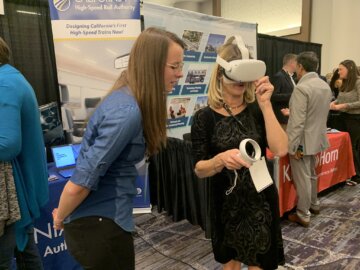 Southern California’s outreach efforts kicked into high gear this fall with a series of events as we rolled out a first look at the inside of our train cars. In Anaheim, which happens to be the final stop of our Phase 1 alignment, we took the opportunity to host an exhibit booth at Mobility 21 in late September alongside our Early Train Operator, Deutsche Bahn, which is working on designing the interiors for our rail cars. Using virtual reality technology, Deutsche Bahn offered attendees the ability to see inside a high-speed rail car and provide feedback and suggestions on what they want to see, feel, and experience on the nation’s first high-speed rail trains.
Southern California’s outreach efforts kicked into high gear this fall with a series of events as we rolled out a first look at the inside of our train cars. In Anaheim, which happens to be the final stop of our Phase 1 alignment, we took the opportunity to host an exhibit booth at Mobility 21 in late September alongside our Early Train Operator, Deutsche Bahn, which is working on designing the interiors for our rail cars. Using virtual reality technology, Deutsche Bahn offered attendees the ability to see inside a high-speed rail car and provide feedback and suggestions on what they want to see, feel, and experience on the nation’s first high-speed rail trains.
To kick off the spooky season, commonly known as October, we engaged with regional stakeholders and local business owners about our high-speed rail project, the role of small businesses, and how other small businesses can get involved at the Southern California Business Development Conference hosted by the Regional Hispanic Chamber of Commerce in Long Beach. To cap off October, we headed to Universal Studios – not for Horror Nights – to network and share project updates at the VICA Business Forecast. Attendees ranging from business leaders to elected officials. Lots of visitors stopped by our booth to hear the latest about our project’s construction in the Central Valley and EIR/EIS progress in the greater Los Angeles region.
As the holidays and cooler weather are upon us, so are more Southern California events. You can stay up to date on our public meeting schedule by visiting our website at https://hsr-staging.hsr.ca.gov/communications-outreach/info-center/events/. And be sure to follow us on Instagram, LinkedIn, and Facebook to stay up to date on what we’re up to next.
Palmdale Plans for High-Speed Changes
Exciting plans are taking shape in the city of Palmdale to create a transportation hub that connects residents of Los Angeles County with the California High-Speed Rail Authority’s route from San Francisco to Los Angeles.
The Authority’s service will provide a faster travel option for commuters between Palmdale and the Los Angeles basin, and connections with other rail services at the Palmdale Transportation Center, such as regional rail options, expanded Metrolink, Amtrak, Greyhound, and other bus/transit services.
The Authority’s service will be part of vast travel improvements for Palmdale. The city will see new opportunities for economic development and connections to many destinations and transportation options. There will be enhanced performance and safety, with reduced pollution by using next-generation technology like positive train control, intrusion barriers, and an early earthquake warning system.
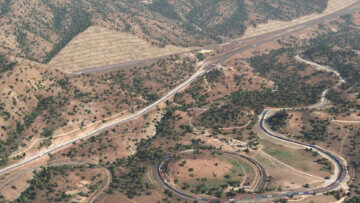 Mayor Laura Bettencourt presides over Palmdale as it experiences this unique opportunity in transportation. “Palmdale looks forward to being a major connection hub between the CA High-Speed Rail Authority Project from Bakersfield and northern California and the Brightline West project from the Victor Valley and Las Vegas,” Bettencourt said. “We were recently awarded an $8 million Caltrans grant to support preliminary engineering and other project development activities for the High Desert Corridor Intercity High-Speed Rail Project spanning 54 miles between Palmdale and the Victor Valley.”
Mayor Laura Bettencourt presides over Palmdale as it experiences this unique opportunity in transportation. “Palmdale looks forward to being a major connection hub between the CA High-Speed Rail Authority Project from Bakersfield and northern California and the Brightline West project from the Victor Valley and Las Vegas,” Bettencourt said. “We were recently awarded an $8 million Caltrans grant to support preliminary engineering and other project development activities for the High Desert Corridor Intercity High-Speed Rail Project spanning 54 miles between Palmdale and the Victor Valley.”
The city’s Transit Area Specific Plan addresses land development options in the approximately 750 acres surrounding the future mixed-use train station. The plan looks to support sustainable economic and social development. The plan includes a pedestrian-oriented district within an area designed for commercial and public use. It will be a vibrant mixed-use center that represents sustainable economic and social development, with the vision of a better Palmdale band ringing smart growth development opportunities.
The Pacific Crest Trail is part of the Authority’s Bakersfield to Palmdale project section, an approximately 80-mile corridor that travels through or near the cities of Edison, Tehachapi, Rosamond, Lancaster, and Palmdale. The project section will span the Tehachapi Mountains with a modern rail line that closes the current passenger rail gap between Central and Southern California.
On Aug. 19, 2021, the California High-Speed Rail Authority’s Board of Directors approved the final Environmental Impact Report/Environmental Impact Statement for the section from Bakersfield to Palmdale. The action paved the way for full environmental clearance of nearly 300 miles of the high-speed rail project’s 500-mile alignment from San Francisco to Los Angeles and Anaheim. For more information on the Bakersfield to Palmdale Project Section go to: https://tinyurl.com/ykxufruv.
The Authority and Palmdale are collaborating on station area design. The vision for the station is a 21st-century gateway, bringing together citizens from Palmdale while welcoming visitors from the region and the state. The union of transportation, community, and the environment – in a multi-modal high-speed rail station – will transform the way residents live and work. And it just might help them get to their favorite LA Dodgers game on time! (Or, if you must, a San Francisco Giants game.)
Long History of Service Moves Calvada Forward
In 1972, Armando DuPont wasn’t thinking about starting a land surveying company. Events for the history books were unfolding around him, even if their importance didn’t have the same weight they hold now in retrospect. A space race. Ongoing global conflict. And if you’re into the record books – the only perfect NFL season.
While the nation and world were taking shape around him, November 1972 marked the start of an experience that would shape and teach him lessons that would later influence how he operates Calvada Surveying Inc. (Calvada) – he was drafted into the Army.
“My Army experience is one that I would not miss in my life,” DuPont said.
DuPont was assigned to the First Infantry Division in Fort Riley, Kansas. At Fort Riley, DuPont received training for numerous functions and skills to serve as a chemical, biological, and radiological technician in the event of a deployment. In other words, “In charge of the flame-throwers, the injections for any biological damage incurred, gas masks, etc.,” DuPont said.
DuPont toured Germany for NATO exercises before he was honorably discharged and served as a reservist for another five years. His time in the Army left him with a lasting impression, experiencing growth and instilling the stamina and maturity to keep moving forward – traits that helped him steer the ship at Calvada for more than three decades.
Founded in December 1988, 16 years after being drafted to the Army, DuPont left his position with a civil engineering company as he envisioned a business of his own to provide better and faster land surveying and aerial photogrammetry mapping services to clients.
Like any new business, obtaining clientele was one of the biggest obstacles. “My biggest challenge was to convince anyone, future client[s], to trust me,” he said.
The right mentality and the stamina to move forward helped DuPont leap over that obstacle – figuratively this time, in contrast to the literal obstacle leaping during basic training in the years prior.
 Finding clients isn’t much of a challenge these days. The full-service land surveying company has offices across California and other western states.
Finding clients isn’t much of a challenge these days. The full-service land surveying company has offices across California and other western states.
Over the years, DuPont and Calvada have been the lead surveyors for large infrastructure projects within California, providing highly detailed topographic surveys and boundary analysis for many miles of Interstate 605, State Route 60, Interstate 10, and Interstate 5. They were even the first surveyors on site for Disney’s California Adventure Park – well before a single patron enjoyed a famed churro or turkey leg there.
Calvada uses the latest land surveying technology, including drone surveying and high-definition surveying (HDS), also known as 3D laser scanning. This powerful technology allows Calvada to quickly provide accurate 3D drawings.
For the California High-Speed Rail project, Calvada works on the Fresno to Bakersfield project section. California’s varied terrain and landscape require innovative engineering and land mapping when planning and designing high-speed rail across regions.
The significance of working on the nation’s largest infrastructure project and first high-speed rail system isn’t lost on DuPont. “I like it. It will be something we can brag about,” he said.
DuPont remains confident in the future of the company he founded nearly 35 years ago and still finds himself saying yes to any work opportunities that come his way. It’s all about pushing through to achieve a goal.
“Attitude is half the battle,” DuPont says as he shares the most important lesson he learned during his time in the Army. “If one applies this to everything we do, it opens the doors everywhere. Always approach every problem with the right attitude and a solution.”
Authority Gets New Plan for Los Angeles to Anaheim
 The California High-Speed Rail Authority continues to advance work to deliver the nation’s first high-speed rail program. The Los Angeles to Anaheim Project reached a new milestone in November, moving closer to connecting LA/Anaheim to the Central Valley and San Francisco with a one-seat high-speed train ride.
The California High-Speed Rail Authority continues to advance work to deliver the nation’s first high-speed rail program. The Los Angeles to Anaheim Project reached a new milestone in November, moving closer to connecting LA/Anaheim to the Central Valley and San Francisco with a one-seat high-speed train ride.
In 2020, the Authority conducted a Revised Scoping process to propose two new project components, the BNSF Colton Intermodal Facility (IMF) and BNSF’s Lenwood Staging Tracks. The Colton IMF accommodated the future growth of passenger rail operations on dedicated passenger tracks and reduced the project’s potential impacts on freight rail by shifting some freight operations outside of the project corridor.
As a result of comments received during public scoping, subsequent meetings with partner agencies and key stakeholders, and waning interest from BNSF, the Authority prepared a Supplemental Alternatives Analysis (SAA) to evaluate a new alternative that would eliminate the need for a BNSF IMF in San Bernardino County.
The SAA was presented to the Authority Board of Directors on November 2 and can be viewed here. The SAA considers three new build alternatives that do not include an IMF and proposes to advance the Shared Passenger Track Alternative for further consideration in the draft environmental documents (EIR/EIS). The Shared Passenger Track Alternative generally resembles the current 2018 High-Speed Rail (HSR) Project Alternative and, among the new alternatives studied in this SAA, best meets the Project’s purpose, and need by serving the most potential passengers in the most cost-effective manner, while also reducing impacts to the environment, existing rail operations, and communities.
Upcoming Events
Here are upcoming events that you won’t want to miss!
Napa Valley Wine Train Jolly Journeys
December 20-23 (select dates)
All aboard for a merry adventure through Napa Valley! Jingle and mingle in elegant railcars and enjoy the stunning views while sipping a cup of hot cider or cocoa. Click here for more information.
Roaring Camp Holiday Lights Train
December 20-23
A seasonal tradition returns with the Santa Cruz Holiday Lights Train. Enjoy holiday festivities aboard vintage excursion cars adorned with thousands of colorful lights. Click here for more information.
UC Davis Engineering, Energy and Technology Career Fair
January 24
10 a.m. – 2 p.m.
Talk with Authority staff about how to get a job on the nation’s first high-speed rail program or with the State of California. Click here for more information.
A Day in Her Shoes Conference
March 8
The Authority will participate in this all day event in Murrieta as we celebrate and share our experiences about working in the field of transportation and rail. Click here for more information.
US High-Speed Rail Association Annual Conference
May 14-15
Join our CEO Brian Kelly and other leaders in the industry about how they are working to deliver high-speed rail to the United States. Click here for more information.
Quarterly Newsletter Archive
- Spring 2023 All Aboard Newsletter
- Winter 2023 Quarterly Newsletter
- Fall 2022 Quarterly Newsletter
- Summer 2022 Quarterly Newsletter
- Spring 2022 Quarterly Newsletter
- Winter 2022 Quarterly Newsletter
- Fall 2021 Quarterly Newsletter
- Summer 2021 Quarterly Newsletter
- Regional Newsletter - May 2021
- Regional Newsletter - February 2021
- Regional Newsletter - November 2020
- Regional Newsletter - August 2020
- Regional Newsletter - June 2020
- Regional Newsletter - February 2020
- Regional Newsletter - November 2019
- Regional Newsletter - August 2019
The California High-Speed Rail Authority makes every effort to ensure the website and its contents meet mandated ADA requirements as per the California State mandated Web Content Accessibility Guidelines 2.0 Level AA standard. If you are looking for a particular document not located on the California High-Speed Rail Authority website, you may make a request for the document under the Public Records Act through the Public Records Act page. If you have any questions about the website or its contents, please contact the Authority at info@hsr.ca.gov.



